Have you ever seen a hummingbirds in Michigan hovering near a flower and feeling mesmerized by its speed and beauty? These tiny birds are nature’s wonders.
Michigan provides an ideal environment for hummingbirds by offering abundant food sources, shelter, and migration pathways. But how can you attract them to your yard and help protect these delicate creatures?
In this guide, we’ll explore the best plants, feeding tips, migration patterns, and fun facts about hummingbirds in Michigan.
Why Michigan Is A Haven For Hummingbirds?
Have you ever watched a hummingbird hover near a flower and wondered why Michigan attracts so many of them? Even though Michigan is in the northern U.S., it provides everything hummingbirds need, from food to safe nesting spots and migration pathways.
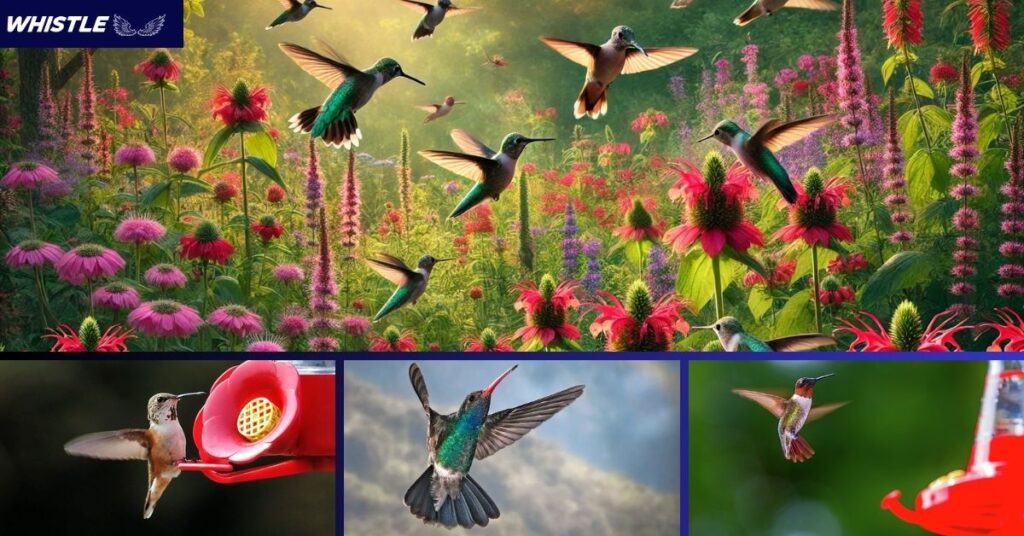
Plenty of Nectar-Producing Flowers:
Michigan has many wildflowers that they love. Flowers like Bee Balm, Cardinal Flower and Trumpet Vine produce nectar, which gives them energy. Gardens, forests and meadows across the state offer plenty of food throughout the warmer months.
Perfect Breeding and Nesting Areas:
The Ruby-Throated Hummingbird, Michigan’s most common species, nests in woodlands, parks and gardens. Females build small cup-shaped nests in trees and shrubs where they keep their eggs safe from predators.
Important Stop for Migrating Hummingbirds:
They travel thousands of miles between North America and Central America. Michigan is an essential stop along their journey. The Great Lakes help guide them while the state’s rich plant life provides the food they need to refuel.
Support from Bird Lovers:
Many people in Michigan help them by planting nectar-rich flowers, setting up feeders and joining bird tracking programs. This makes the state even more welcoming for these tiny birds.
Safe and Diverse Habitats:
They need safe places to feed, rest and nest. Michigan offers a mix of gardens, woodlands and wetlands that meet all their needs.
3 Types Of Hummingbirds In Michigan – You Must Discover!
While Michigan isn’t home to a wide variety of these birds, a few species can be spotted throughout the year.
| Hummingbird Species | Common in Michigan? | Distinctive Features |
| Ruby-Throated Hummingbird | Yes | Green body, red throat (males) |
| Rufous Hummingbird | Rare | Orange-brown plumage, aggressive |
| Calliope Hummingbird | Very Rare | Small size, streaked throat |
1. Ruby-Throated Hummingbird (Archilochus colubris):
- Size: Approximately 3–3.75 inches (7.5–9.5 cm) in length, with a wingspan of 3.1–4.3 inches (8–11 cm).
- Weight: Around 2–6 grams, roughly the weight of a penny.
- Male: Vibrant iridescent red throat (gorget) that can appear black in low light, metallic green back, grayish-white underparts, and a slightly forked tail.
- Female: Lacks the red gorget, with a white throat sometimes faintly streaked, a greenish back, and a rounded tail with white-tipped outer feathers.
- Juveniles: Resemble females, though young males may show some red spotting on the throat.
Ruby-Throated Hummingbirds are well known for their active and dexterous flight. They mostly consume nectar from tubular flowers such as bee balm, trumpet vine, and columbine, which they extract with their long, specialized tongues, and also eat tiny insects and spiders for protein, especially when breeding.
Their flight is a wonder of accuracy, with wings fluttering 50–80 times per second, enabling them to hover, fly backward, and travel at speeds of up to 30 mph. Males are highly territorial, fiercely defending feeding grounds and roosts by attacking intruders, such as other hummingbirds, bees, or even larger birds.
They are also found in open woodlands, meadows, suburban gardens, especially where nectar flowers or hummingbird feeders are plentiful. Females build small, cup-shaped nests, measuring 1–2 inches in width, during the breeding season (May–August), with plant down, spider silk, and lichen for protection, usually suspending them 10–20 feet from ground level in a tree or shrub.
In Michigan, they are common from the Upper Peninsula to southern parts, visiting areas with flowering plants such as salvia and cardinal flower. Their tolerance of human-altered habitats, such as backyards with feeders, renders them a common sight in urban and rural areas.
By feeding on small insects, they also have a positive role in pest control, which helps the garden and the forest. Their presence aids in biodiversity since the flowers they pollinate are a source of food and shelter for other wildlife. In Michigan, their abundance during summer improves local ecosystems, especially where native wildflowers occur.
It is a summer resident, arriving in late April or early May and departing by September or early October. These birds undertake a remarkable migration, traveling up to 2,000 miles from their breeding grounds in eastern North America to wintering grounds in Central America, often crossing the Gulf of Mexico in a single 500-mile nonstop flight lasting 18–22 hours.
Read More About: Green Cheeked Conure – A Complete Guide for Pet Owners!
2. Rufous Hummingbird (Selasphorus rufus):
- Size: About 3–3.5 inches (7.6–9 cm) in length, with a wingspan of 4.3 inches (11 cm).
- Weight: Approximately 2.8–4.5 grams.
- Male: Distinctive bright orange-brown (rufous) plumage on the back, sides, and tail, with a brilliant iridescent orange-red gorget. The underparts are white, and the tail is slightly forked.
- Female: Greenish back with rufous wash on the sides and tail base, white underparts, and some throat streaking. The tail has white-tipped outer feathers.
- Juveniles: Similar to females, with males developing more rufous coloring as they mature.
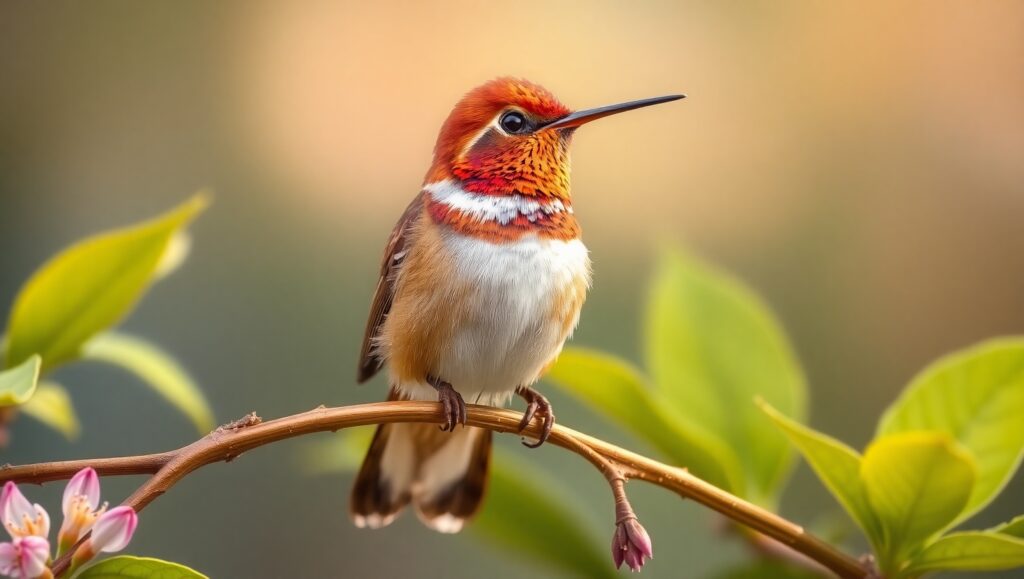
Rufous Hummingbirds are, in fact, some of the most aggressive and feisty hummingbirds, even though they are small. For example, they take nectar from brightly colored flowers like penstemon, paintbrush, and columbine, especially red or orange tubular flowers, and complement their diet with small insects like gnats and flies. Furthermore, their flight is rapid and darting, with fast wingbeats allowing for quick maneuverability.
Moreover, they are famous for their aggressive territoriality, aggressively protecting feeding grounds by frequently driving other hummingbirds, bees, and even bigger birds such as sparrows away. In their breeding ground, more particularly the Pacific Northwest to Alaska, Rufous Hummingbirds inhabit open woodlands, coniferous woods, and montane meadows.
Though in migration, however, they are very adaptable, found in various types of environments including coastal areas, deserts, urban gardens, and suburban backyards. Thus, in Michigan, as they are occasional vagrants there, they can most readily be seen in gardens or feeders, particularly in southern areas of the state late in the summer or in autumn.
Their feeding on insects helps keep pest species in check, hence benefiting ecosystems that they pass through. However, in Michigan, they have little ecological effect because they are so rare, yet their occurrence in feeders can have a local effect on hummingbird dynamics, sometimes driving out Ruby-Throated Hummingbirds. Consequently, their occasional appearance gives useful information for monitoring patterns of migration and changes in the environment.
3. Calliope Hummingbird (Selasphorus calliope):
- Size: The smallest hummingbird in North America, measuring about 2.8–3.2 inches (7–8 cm) with a wingspan of 4.1 inches (10.5 cm).
- Weight: Approximately 2–3 grams, lighter than a dime.
- Male: Metallic green back, white underparts, and a distinctive gorget with magenta streaks that form a “V” shape when flared. The gorget appears dark when not reflecting light.
- Female: Greenish back, white underparts with faint throat streaking, and a shorter bill and tail compared to males. The tail has minimal white tipping.
- Juveniles: Resemble females, with males gradually developing the streaked gorget.
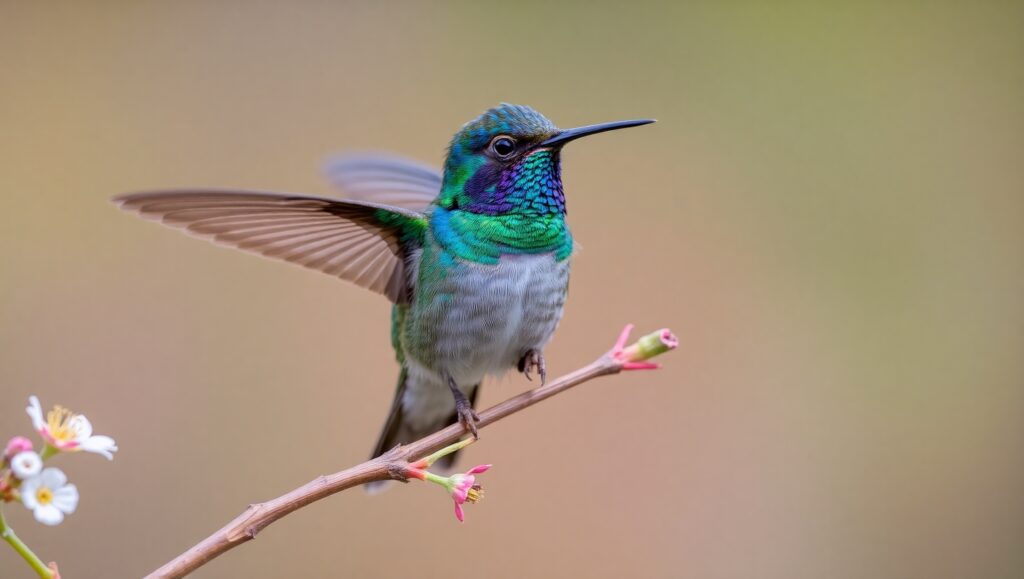
Calliope Hummingbirds, most particularly the most diminutive one in North America, demonstrate poised yet resilient character. As illustration, they glean nectar from tiny, fragrant flowers such as currant, gooseberry, and paintbrush with the help of short bills and long tongues, while they also use small insects to provide protein intake.
In addition, they display fast, sharp flight patterns though their more modest size emits less intense humming. Conversely, they are not as aggressive as birds such as the Rufous, since Calliopes are usually subordinate where they share a feeding ground and move cautiously around dominant birds.
During migration, they settle in diverse habitats, such as lowland gardens, deserts, and urban areas with nectar sources. As a result, in Michigan, where they are very rare, they can turn up in gardens or at feeders, especially in late summer or autumn.
Particularly, their accurate feeding behaviors allow pollen transport for species such as gooseberry and currant in their native habitat, thus facilitating plant diversity. Nonetheless, ecologically, their influence is insignificant in Michigan owing to their infrequency, but their occurrence indicates the resilience of hummingbirds to human-altered habitats such as gardens.
By eating small insects, they make a secondary contribution to pest control. Consequently, unusual sightings in Michigan give ornithologists important information on migration irregularities and the influence of environmental conditions, including climate change, on hummingbird dispersal.
Creating A Hummingbird-Friendly Habitat In Michigan!
Convert your Michigan garden into a colorful sanctuary for Ruby-Throated Hummingbirds and occasional Rufous or Calliope guests by establishing a hummingbird-friendly environment. By including nectar flowers, feeders, water features, and adequate shelter, you can successfully accommodate these pollinators and, in turn, enhance biodiversity.
Plant Nectar-Rich Native Flowers:
To entice hummingbirds, start by adding native flowers that yield copious nectar. For example, Bee Balm (Monarda) has showy red tubular flowers from mid-summer through fall, which do well in full sun or partial shade.
In addition, Columbine (Aquilegia canadensis) has red-and-yellow flowers in spring that attract early visitors and grows best in partial shade and moist soil. Moreover, Cardinal Flower (Lobelia cardinalis) has red spikes July to September and thrives in moist, shady spots. Finally, Salvia (Salvia spp.) has red, purple, or blue-blue flowers throughout summer, ideal for sunny spots.
Utilize Hummingbird Feeders:
Feeders successfully supplement nectar, especially during migration. First, make a nectar solution by dissolving one part sugar in four parts water, boiling, and cooling without dye or honey. Second, suspend feeders in shaded spots near flowers, 10–15 feet apart to reduce territorial conflicts. In addition, clean feeders every 3–4 days using a vinegar-water solution to avoid mold. Lastly, install feeders in April and keep them running until October to assist late migrants.
Offer Water:
Hummingbirds require water for drinking and bathing. For instance, a soft mister or fountain close to cover draws them to bathe. Or, a shallow birdbath with water less than one inch deep, with pebbles to land on and daily water changes, is effective.Offer Shelter:
To create safe spaces, incorporate native trees or shrubs like dogwood or viburnum for perching and nesting. Additionally, add thin branches near feeders for resting spots. Importantly, avoid pesticides to preserve insects, which are a vital food source for hummingbirds.
MORE FOR YOU: 20 Coastal Birds of NC (North Carolina) with Pictures!
The Best Plants To Attract Hummingbirds In Michigan!
Planting native flowers is the best way to invite hummingbirds into your garden. These plants offer a natural source of nectar, essential for their survival.
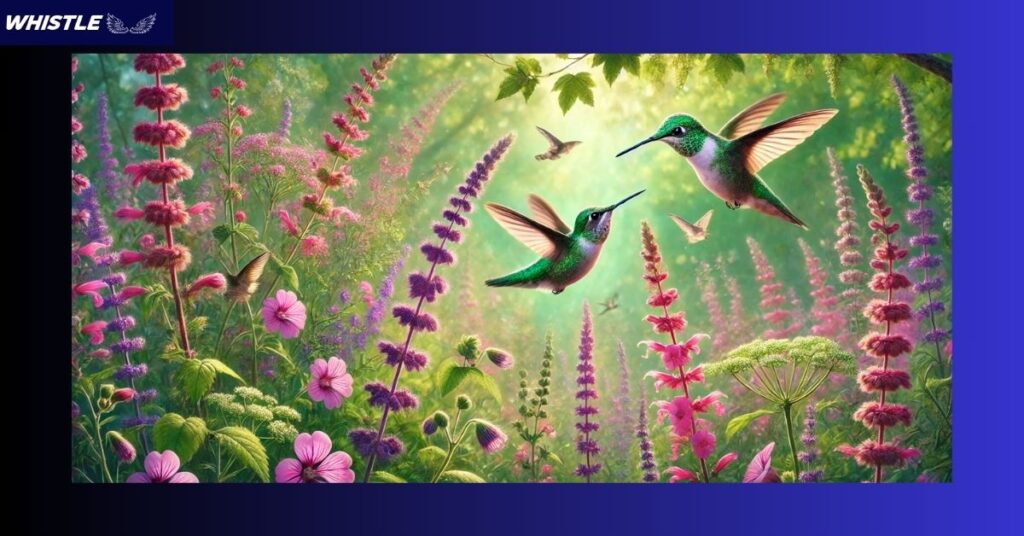
To attract hummingbirds like the Ruby-Throated, Rufous, and Calliope to your Michigan garden, planting nectar-rich flowers is essential. Bee Balm (Monarda), with its vibrant red, tubular flowers, is a magnet for hummingbirds, blooming from mid-summer to early fall and providing a reliable nectar source for Michigan’s summer residents.
Its fragrant leaves also contribute to garden beauty, performing well in full sun to partial shade and dry to moist, well-drained soil. Trumpet Vine (Campsis radicans) also has large, orange-red tube-shaped flowers that provide plenty of nectar, perfect for hummingbirds’ extended bills, and flowers from June to September, benefiting late-summer migrants such as the Rufous.
Therefore, this aggressive climber thrives in full sun and can cover trellises but needs to be pruned to keep it in check. For early bloomers, Columbine (Aquilegia canadensis) provides dainty, red-and-yellow, bell-shaped flowers that open in spring, drawing Ruby-Throated Hummingbirds as they arrive in April.
This indigenous perennial does well in partial shade and wet soil, ideal for woodland gardens. Cardinal Flower (Lobelia cardinalis) with its long spikes of vivid red flowers is a hummingbird magnet, blooming from July to September and performing well in wet, partially shaded conditions such as stream banks or rain gardens.
Finally, Salvia (Salvia spp.) provides a constant food supply through its bright, tubular flowers that bloom during summer months in red, purple, and blue hues, tolerant of sunny, well-drained locations. These Michigan hummingbird plants offer not only nectar but also pollination assistance since hummingbirds carry pollen from plant to plant as they eat, promoting biodiversity.
By adding these nectar flowers and native blooms, gardeners can build a hummingbird sanctuary, increasing the likelihood of seeing these nimble birds while supporting a healthy ecosystem.
Is It Good To Have A Hawk In Your Yard?
Hawks are natural predators of hummingbirds but their presence can help control other pest populations like rodents. If you want a hummingbird-friendly yard try to limit hawk-attracting elements such as bird feeders with easy prey.
Pros and Cons of Having Hawks Around:
| Pros | Cons |
| Helps control rodent populations | Can prey on hummingbirds |
| Keeps ecosystem balanced | Scares away smaller birds |
| Reduces overpopulation of certain bird species | May lead to fewer hummingbird sightings |
Tips For Feeding Hummingbirds!
Feeding hummingbirds the right way can help them stay healthy and encourage more visits to your yard. A well-maintained feeder with fresh nectar provides a reliable food source. Follow these simple tips to keep your hummingbird guests happy.
Make the Perfect Nectar:
- Mix 1 part white sugar with 4 parts water.
- Boil the mixture, let it cool, and fill the feeder.
- Avoid honey, artificial sweeteners, and red dye—these can harm them
Choose the Right Feeder:
- Use a red-colored feeder with multiple feeding ports.
- Avoid feeders with yellow accents, as they attract bees.
- Pick a design that is easy to clean and refill.
Clean Feeders Regularly:
- Change nectar every 2-3 days in summer and every 4-5 days in cooler weather to prevent fermentation.
- Rinse with warm water and vinegar—never use soap, which can leave harmful residue.
Place Feeders Strategically:
- Hang feeders in partial shade to keep nectar fresh longer.
- Keep feeders away from windows to reduce bird collisions.
- Space feeders apart to reduce territorial fights between them.
Keep Ants, Bees, and Wasps Away:
- Use ant moats to block ants from reaching nectar.
- Attach bee guards to prevent insects from drinking nectar.
- Avoid petroleum jelly or sticky substances, as they can harm birds.
The Migration Patterns Of Hummingbirds!
Providing fresh nectar is essential for them in Michigan migrations. Mix one part white sugar with four parts water, boil it and let it cool before filling the feeder. Choose a red-colored feeder with multiple ports and avoid yellow accents that attract bees.
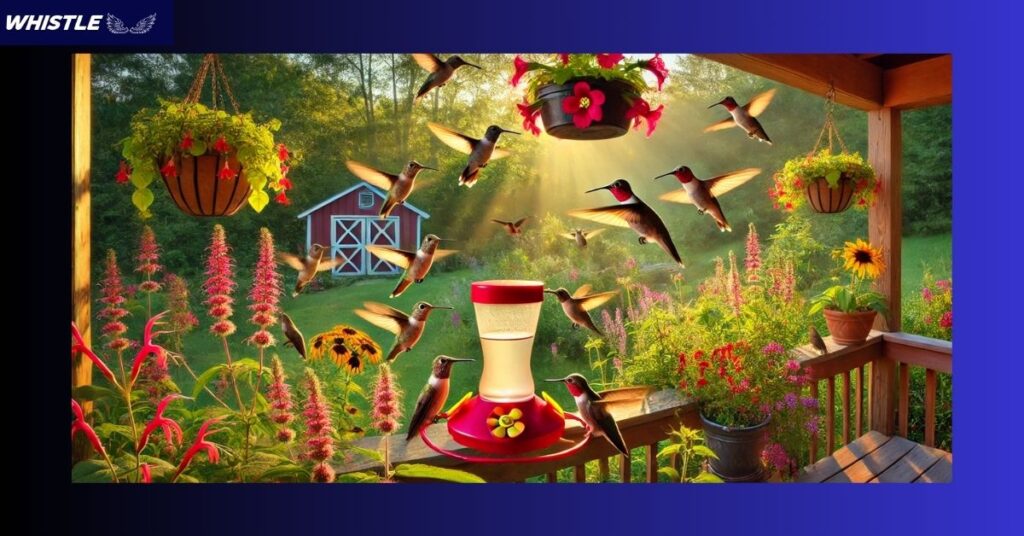
Clean the feeder every 2-3 days in summer and every 4-5 days in cooler weather using warm water and vinegar. Place feeders in partial shade, away from windows, and space them apart to reduce territorial fights.
Use ant moats and bee guards to keep insects away. By maintaining a clean and safe feeding station, you can support Michigan’s these throughout their journey.
Protecting Hummingbirds – Conservation Efforts!
They face serious threats from habitat loss, climate change, and window collisions but simple conservation efforts can help protect them. Gardeners plant native flowers like Bee Balm, Cardinal Flower, and Trumpet Vine.
Pesticides harm them by killing the insects they rely on for protein, so bird lovers avoid chemical sprays to keep their food sources safe. Many birds suffer from window collisions but homeowners can install decals or screens to reduce these accidents.
By making small changes in your yard and supporting conservation efforts, you can help Michigan’s hummingbirds thrive for generations to come.
Capturing The Beauty Of Michigan’s Hummingbirds Through Photography!
Photographing them takes skill, patience, and the right equipment. These tiny birds move quickly, but with the right techniques, you can capture stunning images. Follow these tips to get the best shots of Michigan’s hummingbirds.
Use a Fast Shutter Speed:
Set your camera to 1/2000s or faster to freeze their rapid wing beats and capture sharp details.
Choose the Right Camera:
A fast and high-resolution camera makes a big difference in hummingbird photography. Consider these options:
- Canon EOS R6 – Delivers fast autofocus and excellent low-light performance.
- Nikon D850 – Offers a high-resolution sensor and fast burst shooting.
- Sony A7 IV – Provides lightweight handling and superior autofocus for birds in motion.
- Olympus OM-D E-M1X – Tracks fast-moving subjects with precision and works well for wildlife photography.
Shoot in Soft Lighting:
Photograph birds in the early morning or late afternoon to avoid harsh shadows and create a natural, warm glow in your images.
Position Near Feeders or Flowers:
They return to the same feeding spots throughout the day. Set up your camera near nectar-rich flowers or feeders and wait for them to arrive.
Stay Patient and Take Multiple Shots:
As they move fast, you need patience. Use a tripod or monopod to stabilize your camera and take multiple shots to increase your chances of capturing the perfect moment.
Interesting Facts About Birds In Michigan!
Hummingbirds are tiny but full of amazing abilities! Here are some fun and fascinating facts about these energetic birds:
Incredible Wing Speed – Their wings flap 50 to 80 times per second, making a humming sound as they fly.
Constant Eaters – They feed every 10-15 minutes and consume twice their body weight in nectar daily.
Masters of Flight – They are the only birds that can fly backward, sideways, and hover in mid-air like a helicopter.
Supercharged Hearts – Their hearts can beat up to 1,200 times per minute, especially when flying.
Built-in Survival Mode – On cold nights, they enter torpor, a deep sleep-like state that helps conserve energy.
How Do You Track 2025 Hummingbird Migration?
Tracking the 2025 hummingbird migration means tracking the seasonal movement of these small birds as they migrate from wintering grounds in Mexico and Central America to breeding grounds in Canada and the United States in spring, and south again in fall. Hummingbirds like the Ruby-throated, Rufous, and Black-chinned species make incredible journeys, some traveling as far as 5,000 miles a year.
This migration process is complemented by the effort of bird watchers submitting the sight, producing maps of current bird migration. Underneath we demonstrate how you may follow the hummingbird’s migration through supported data and methodology.
Interactive Migration Maps:
Sites such as Hummingbird Central and Hummingbird Guide have interactive maps revised hourly or daily by user-reported sightings. As an example, Hummingbird Central’s 2025 Spring Migration Map documents sightings from late January to May for species such as Ruby-throated hummingbirds, which begin to appear in southern U.S. states such as Texas and Louisiana in February. By April 2025, sightings had been reported as far north as New York and Connecticut.
Data Point: Hummingbird Guide’s map has logged over 194 million sightings since 2009, with over 8,000 reports a year, creating a strong dataset for monitoring migration trends.
Submitting Sightings:
You can help track migration by documenting your initial hummingbird sightings through websites such as Hummingbird Central or Journey North. Both sites request information such as species, location, date, sex, and activities (e.g., feeding or nesting). For example, Ruby-throated males normally appear 10-14 days ahead of females, a trend that appears to repeat in 2025 sightings.
Data Point: Hummingbird Central ceased spring monitoring on May 31, 2024, as the majority of hummingbirds had arrived in northern breeding territories in Canada, a schedule most likely repeated for 2025.
Mobile Apps:
Mobile applications such as Hummingbird Tracker by Hummingbird Guide provide real-time monitoring and smartphone reporting of sightings. They enable approximations of dates of arrival through past experience, including Ruby-throated hummingbirds arriving in Michigan by the middle of April.
Data Point: Research shows hummingbirds travel up to 23 miles per day on land and can cover 500 miles non-stop over the Gulf of Mexico, data that apps use to predict movement.
Observing Environmental Cues:
Hummingbirds migrate due to daylight duration and temperature fluctuations. Monitoring regional flowering patterns for flowers with high nectar content, such as salvia or honeysuckle, can provide an estimate of when hummingbirds will appear. In this case, sightings in the southern states correlate with early flowering in February 2025.
Data Point: Hummingbirds pick up 25-40% of their body weight prior to migration, using nectar and insects for energy for flight, with heart rates during migration reaching as high as 1,260 beats per minute.
Why Monitor Hummingbird Migration?
Monitoring assists birders in predicting arrivals to establish feeders, aids conservation by locating habitat shifts, and advances scientific knowledge of migration triggers. For example, 2023 and 2024 had more sightings of albino and leucistic hummingbirds, indicating population dynamic changes or observer sensitivity.
- Set Up Feeders: Position feeders containing sugar water (1:4 solution) two weeks prior to anticipated arrivals, according to past years’ records (e.g., late February for the south U.S.).
- Plant Native Flowers: Red, tubular flowers such as bee balm are attractive to hummingbirds, increasing sightings.
- Avoid Pesticides: Hummingbirds need insects for protein, particularly while nesting, according to Mississippi State University.
To track real-time, go to Hummingbird Central’s 2025 Migration Map to see sightings or report your own.
FAQs:
When To Stop Feeding Hummingbirds In Michigan?
You can keep feeding them until late October to help late migrators. Leaving feeders up a bit longer won’t stop them from migrating, as their instincts tell them when to leave. Once you haven’t seen any for two weeks. it’s safe to take feeders down.
Are Hummingbirds In Michigan Yet?
If it’s spring, check migration maps or look for blooming flowers. They follow nectar sources and may already be on their way.
When Do Hummingbirds Leave Michigan?
Most of them leave Michigan between late September and early October heading south for the winter. Some stragglers may stay longer but they will eventually migrate once temperatures drop and food sources decline.
When Should Hummingbird Feeders Come Down In Michigan?
Take feeders down in mid to late October but if you still see it then keep them up a little longer to support late travelers. Leaving feeders up does not interfere with their migration.
Should A Hummingbird Feeder Be In The Sun Or Shade?
Place feeders in partial shade to keep nectar fresh longer while ensuring they are still visible to birds. Direct sunlight can cause nectar to spoil quickly, so a shaded spot with occasional sunlight works best.
What Is The Number One Flower That Attracts Hummingbirds?
Bee Balm (Monarda) is one of the best flowers for attracting these due to its bright red blooms and high nectar content. Other great choices include Cardinal Flower, Trumpet Vine and Salvia.
Conclusion:
Hummingbirds add beauty and energy to Michigan’s landscapes. Their rapid flight and pollination efforts make them essential to the ecosystem. By planting native flowers and setting up feeders, people create safe spaces for these tiny birds. Many homeowners avoid pesticides to protect their food sources.
They rely on clean feeders and well-maintained habitats. Their migration patterns show how important seasonal food sources are.
Conservationists work to reduce window collisions and track their populations through citizen science programs. Anyone can support Michigan’s hummingbirds by making small changes in their yard.
